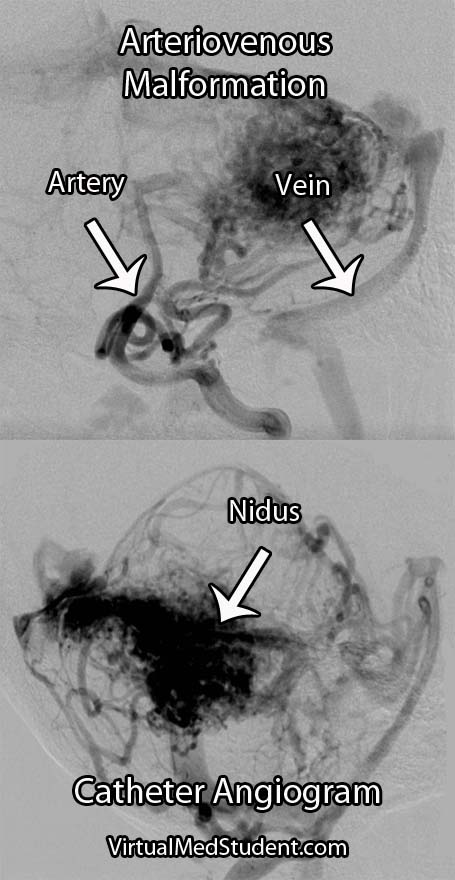A cerebral arteriovenous malformation is an abnormal tangle of blood vessels within the brain.
In order to understand these tangles we have to first understand normal blood flow. Blood flows from arteries to smaller arteries and then into capillary beds. In the capillary beds, gas, nutrients, and "wastes" are exchanged between the blood and adjacent body tissue. Once past the capillaries, the blood drains into successively larger veins where it eventually returns to the heart to be re-oxygenated.
In arteriovenous malformations there are no capillaries. Because of this, blood is shunted from the high pressure arterial system directly into the low pressure venous system. The "shunted" blood is unable to deliver its nutrients or oxygen to the nearby brain.
The risk of an arteriovenous malformation rupturing is relatively high because the pressure of arterial blood is "banging" into the walls of low pressure veins. The body tries to compensate for this by "arterializing" the blood vessels associated with the AVM.
The term "nidus" is often used to describe the center of the malformation. This is the point where the arterial feeding vessels meet the draining venous structures.
In addition, any brain tissue around, or within the AVM is usually gliotic (a term used to describe scarring within the brain). Macrophages are sometimes present and are usually there to "gobble up" hemosiderin (a breakdown product of blood).
Signs and Symptoms
The signs and symptoms of cerebral arteriovenous malformations are dependent on the location of the malformation.
Most patients discover they have an AVM after it bleeds into the surrounding brain tissue. Patients can present with everything from a mild headache to a severe neurological deficit depending on the location and size of the malformation.
In addition, AVMs may cause transient neurological symptoms. These transient symptoms are caused by blood being shunted away from the surrounding normal brain tissue. Again, the location of the AVM dictates what symptoms may develop (ie: weakness if near the motor strip, difficulty with speech if located near Wernicke’s or Broca’s area, balance problems if in the cerebellum, disturbances in sensation if in the parietal lobe, etc., etc.).
Patients may also present with seizures as a result of irritation of the surrounding cortex by hemosiderin (a breakdown product of blood). In fact, seizures are the second most common presenting symptom.
Interestingly, headache is an uncommon symptom of arteriovenous malformations.
Diagnosis and Classification

AVMs are characterized by an abnormal tangle of blood vessels. The tell tale sign of an AVM on an angiogram is that both arterial and venous structures are seen at the same time (normally the venous phase follows the arterial phase).
The Spetzler-Martin grading system helps guide treatment decisions. This system takes into account the size, location, and type of venous drainage (see the first reference below).
Treatment
Treatment is highly individualized. There are currently three accepted treatment strategies: surgery, radiation, and embolization.
Surgery is still the treatment of choice, especially for AVMs near the surface of the brain or in non-eloquent cortex. Surgery is also considered "definitive" therapy (ie: the AVM is removed all at once), which is ideal for lesions considered high risk for rupture. Patient’s with deep seated lesions (ie: basal ganglia, thalamus, etc.), or those located in very "eloquent" cortical areas may be better treated with radiation or embolization.
Radiation works by causing changes in the vessels of the AVM. Over the course of several months to years the vessels are "cooked" by the radiation. This effectively eliminates blood flow into the AVM. Since the effects of radiation take months to years to shut down the AVM, the patient remains at risk for rupture. In addition, side effects from radiation may be permanent in a small percentage of patients.
Embolization is usually used as an adjunct to surgical resection. During embolization, various substances are injected into the AVM. These substances deprive the AVM of its arterial blood flow. This can be very useful prior to surgery to help with intra-operative blood loss (especially for very large AVMs!). Embolization is less commonly used as a stand alone treatment.
Overview
Arteriovenous malformations are abnormal tangles of blood vessels within the brain tissue. They have no intervening capillary bed so arterial blood flows directly into dilated veins. The main risk of an arteriovenous malformation is when it ruptures and bleeds into the surrounding brain. They can cause numerous signs and symptoms depending on their location. They are diagnosed with CT angiograms, MR angiograms, or formal catheter angiograms. Treatment is with surgery, radiation, and/or embolization depending on the risk of rupture and the location of the lesion.
Other Interesting Neurovascular Diseases…
- When Brain Veins Go Bad: Cerebral Sinus Thrombosis
- Vein of Galen Malformations: A Misnomer of Sorts
- Subarachnoid Hemorrhage: Aneurysms, Vasospasm, and Hyponatremia
References and Resources
- Spetzler RF, Martin NA. A proposed grading system for arteriovenous malformations. J Neurosurg. 1986 Oct;65(4):476-83.
- Ding D, Yen CP, Xu Z, et al. Radiosurgery for patients with unruptured intracranial arteriovenous malformations. J Neurosurg. 2013 May;118(5):958-66
- Fokas E, Henzel M, Wittig A, et al. Stereotactic radiosurgery of cerebral arteriovenous malformations: long-term follow-up in 164 patients of a single institution. J Neurol. 2013 May 28.
- Albuquerque FC, Ducruet AF, Crowley RW, et al. Transvenous to arterial Onyx embolization. J Neurointerv Surg. 2013 Mar 6.
- Nataraj A, Mohamed MB, Gholkar A, et al. Multimodality Treatment of Cerebral Arteriovenous Malformations. World Neurosurg. 2013 Feb 20.